INTRODUCTION
The research data confirm the high rate of mortality from the influenza A(H1N1)pdm09 virus during the pandemics 2009-2010 and during the consecutive epidemic seasons [1-9]. The goal of this study was to compare the data on the intensity of the influenza A(H3N2) and B epidemic in the 2014–2015 season with the previous epidemic of 2013-2014 caused by the influenza A(H3N2) and A(H1N1)pdm09 viruses. Special consideration was given to the mortality rate from influenza.
MATERIALS AND METHODS
The data presented in this paper are the results of the influenza epidemiologic surveillance conducted by the Research Institute of Influenza of Russian Ministry of Health according to the order of Rospotrebnadzor No. 373 (March 31, 2005) “On the improvement of influenza and acute respiratory viral infections epidemiologic surveillance and control system” [10]. The data were collected by means of the Research Institute of Influenza database that contains statistics on weekly influenza morbidity, hospitalization, mortality from influenza and acute respiratory viral infections (ARVI) of patients of different age groups, from 59 cities situated in seven Federal Districts of the Russian Federation. The influenza situation assessment for these patients was based on a comparison of the current influenza and ARVI morbidity with the weekly epidemiological thresholds [11]. The antigenic analysis of the influenza viruses was conducted by means of the Hemagglutination inhibition (HI) test with the use of hyperimmune rat’s antisera for the epidemic and reference virus strains.
RESULTS AND DISCUSSION
Until the middle of December 2014, the influenza and ARVI morbidity of the population of 59 cities of the Russian Federation under surveillance did not exceed the epidemic thresholds, meaning that it was below the epidemiological level (Fig. 1). The influenza epidemic in this season started in the 50th week (December 8-14, 2014). During the first two weeks of 2015, the influenza epidemic spread slowed down, but starting from the third week the influenza incidence rate continued to rise. The morbidity among the population in general (and among the children in particular) reached the maximum in the 7th week (February 9-15, 2015) while that of the adult population occurred in the 8th week (February 16-22, 2015). According to the clinical diagnostics data, the influenza morbidity on the peak of epidemic reached 0.6 incidences among a population of 10,000 people. That is, on average, 40 times higher than the non-epidemic rate (0.015 incidences on average). The influenza and ARVI morbidity of the whole population at the peak of the epidemic reached 101.6 incidences among 10,000 people. It was higher than the epidemic thresholds by 77.4% among adults and by 66.4% among children 7 to 14 years old. Thus, the 2015 epidemic started earlier and the morbidity at the peak of the epidemic was higher than that of the previous season [12]. According to the European standards, this epidemic in Russia was of a medium intensity [13].
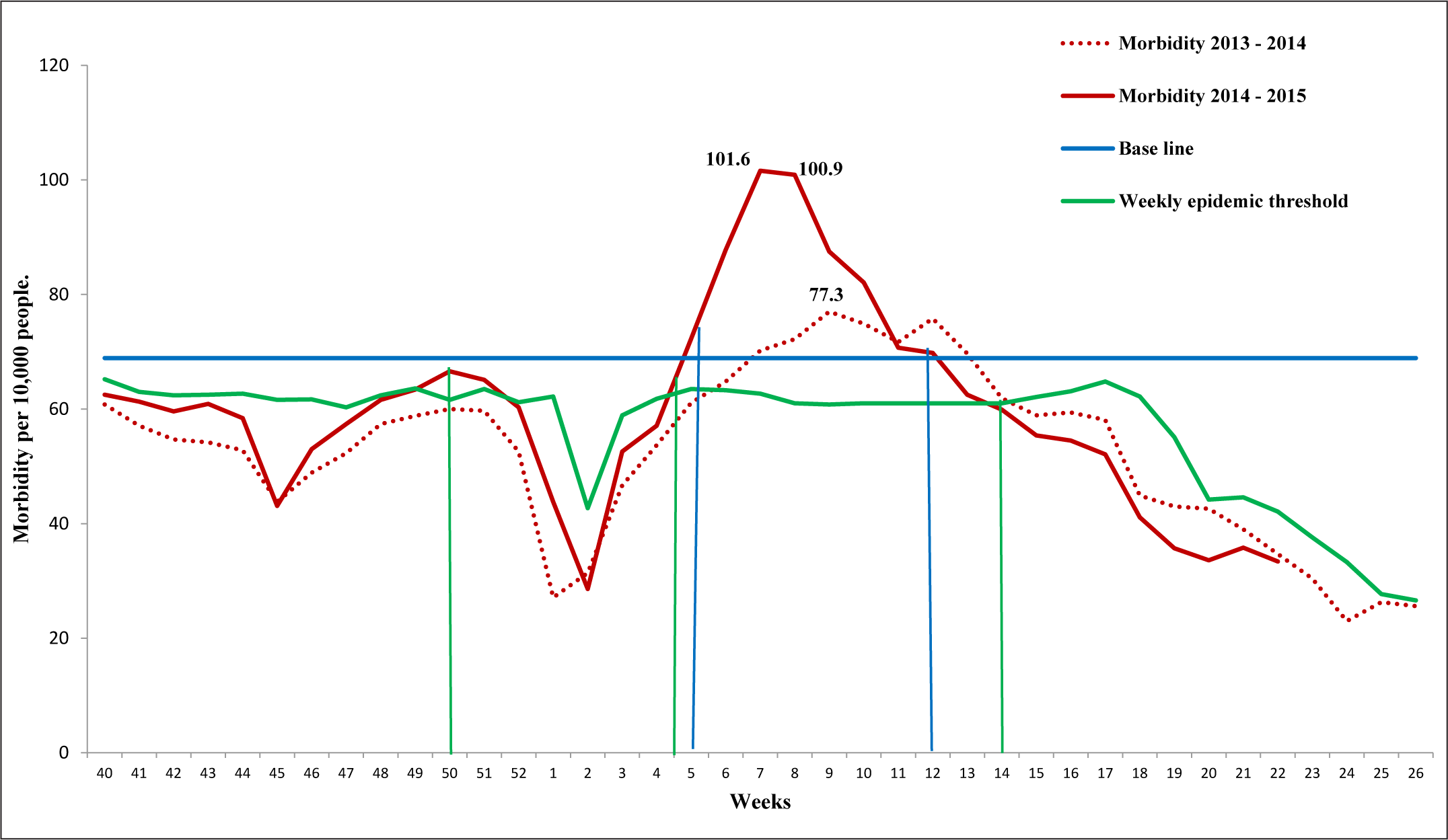
The epidemic started from Nizhnii Novgorod (Privolzhskii Federal District, FD) and from the cities of East Siberia (Chita, Ulan-Ude) where morbidity from December 8-14 2014 exceeded the epidemic threshold among the schoolchildren and then among the adults as well (Fig. 2). Starting from the 3rd week (January 12-18, 2015), the epidemic spread to other cities of the Volga district and Siberia and starting from the 4th week to the Ural region. At the same time - in the 4th week - the epidemic threshold was exceeded in the western part of the country in the cities of Pskov and Smolensk among the schoolchildren. After that, the epidemic spread to the cities of North-West FD and Central FD. Starting in the 5th week (January 26-February 1, 2015), the cities of the Far East and South FDs were drawn into the epidemic.
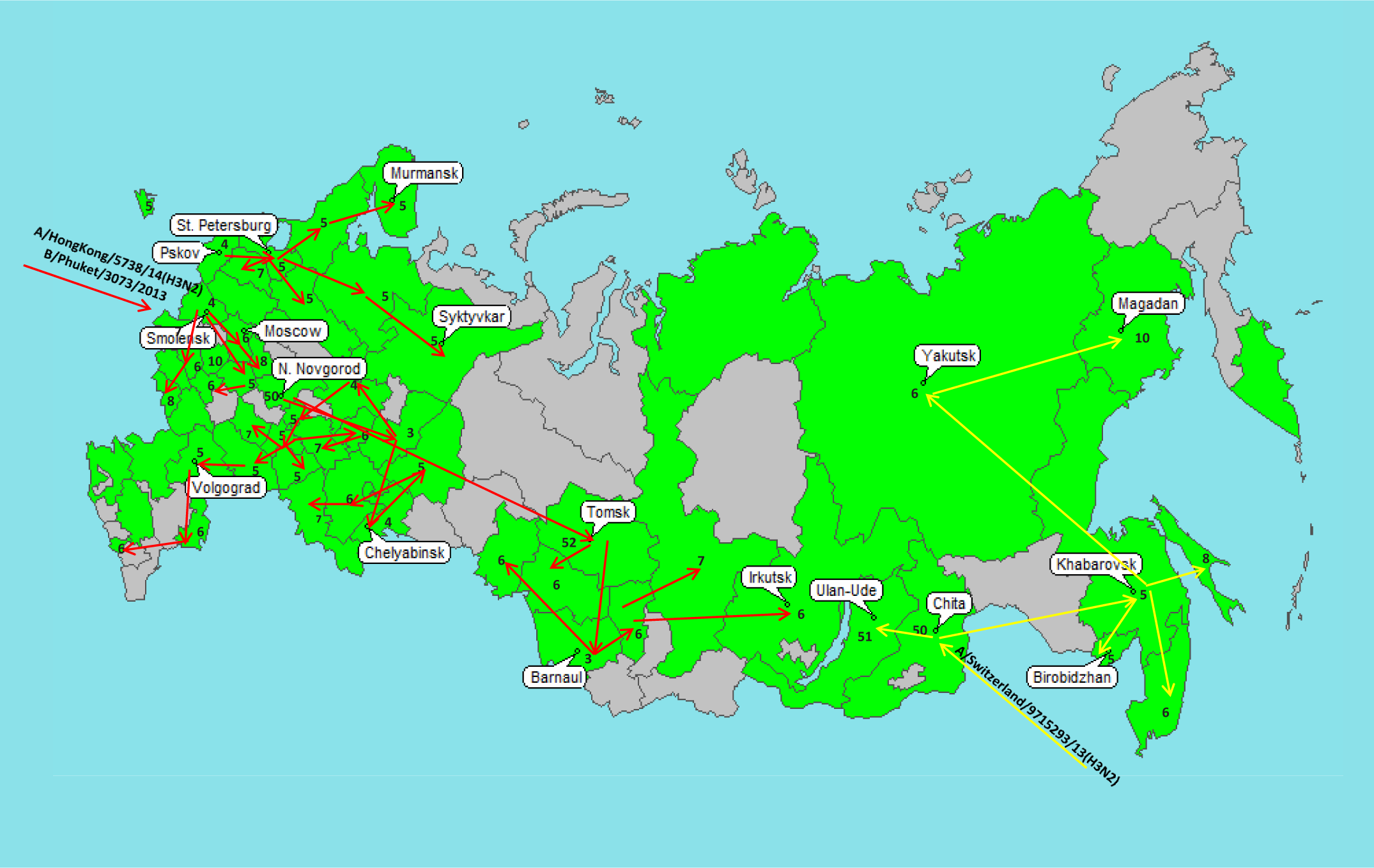
The antigenic analysis of the isolated influenza viruses showed that the influenza virus strains A/Hong Kong/5738/2014 (H3N2) and B/Phuket/3073/2013 were spreading mainly from Europe to the European part of Russia and Western Siberia while the virus strains
A/Switzerland/9715293/2013 (H3N2) - from the East of the Baikal district to the Far East.
During the winter season 2014-2015, the influenza epidemic threshold was exceeded in all of the observed cities of the North-West, Ural and Volga FDs; less influenza activity was recorded in the Siberian and Far East FDs (there was no epidemic in Norilsk and Petropavlovsk-Kamchatskii) and low influenza activity was recorded in Central FD (there was no epidemic in Voronezh, Tver, Yaroslavl and Kursk) as well as in South FD (there was no epidemic in Rostov-on-Don, Stavropol and Krasnodar).
The maximum influenza and ARVI morbidity was detected in the cities of North-East and Ural FDs - among the population in general (8.2% and 7.7%, respectively), among the adult population (3.4% and 3.0%, respectively), among the children 3 to 6 years old (37.2% and 34.5%, respectively) and among the children 7 to 14 years old (23.9% and 16.2%, respectively) (Fig. 3). The rate of morbidity was lower in Volga, Central, Far East, and Siberian FDs - among the population in general (6.2%, 5.7%, 5.5%, and 4.9%) as well as among the different population age groups. The lowest rate of morbidity among the population in general was detected in South FD (2.9%) - among the adults it was 1% while among the schoolchildren it was 11%. The length of the epidemic season reached 6 weeks in Ural FD while in other districts the epidemic lasted 5-5.8 weeks, with the minimum being 3.3 weeks in southern Russia.
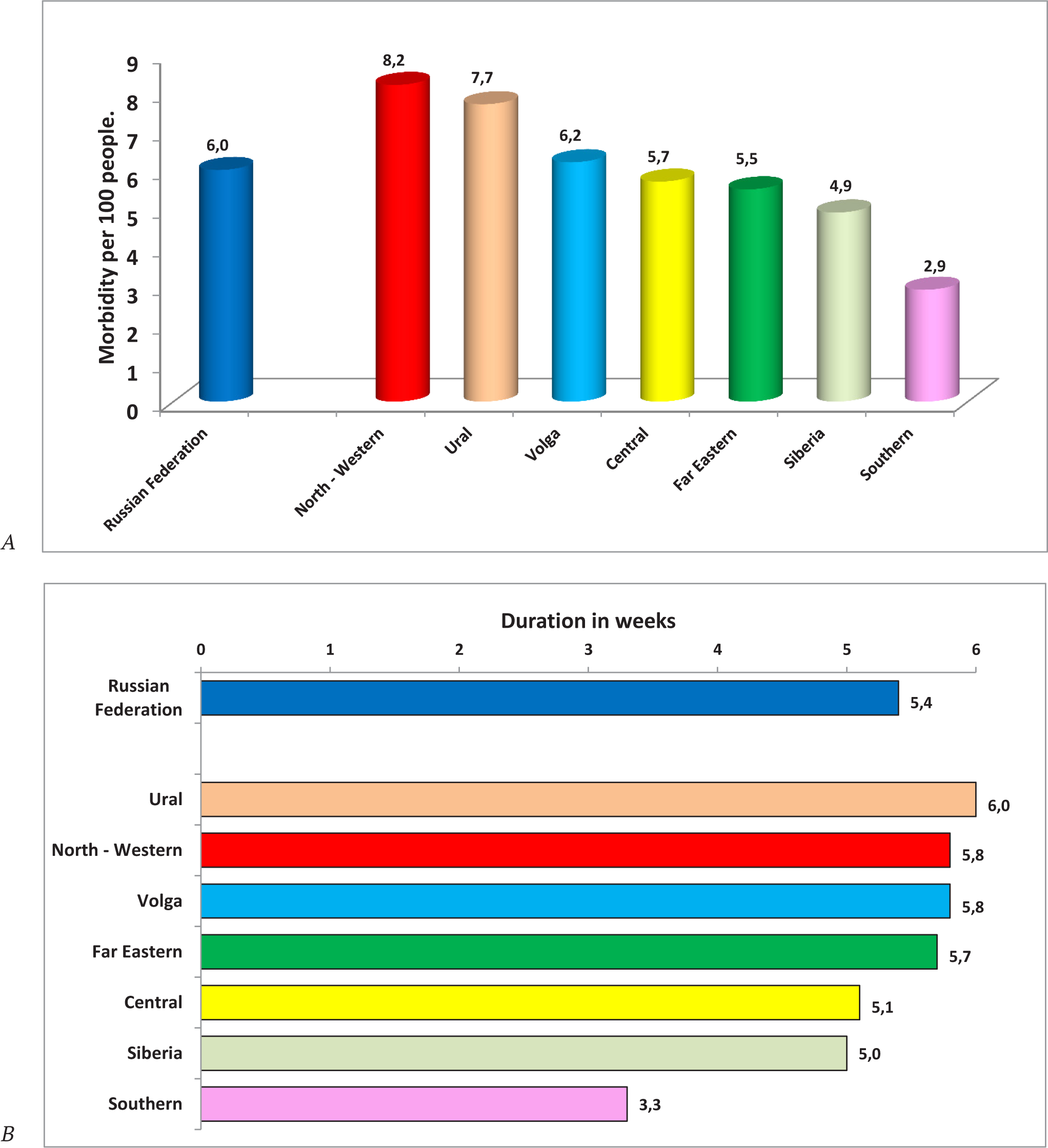
The total epidemic length across the whole country during the season 2014-2015 (starting from the 50th week of 2014 (December 8-14) and ending the 15th week of 2015 (April 6-12) reached 18 weeks (Table.1). From the 59 observed cities, the epidemic threshold among the population in general was exceeded in 48 (81.4%), among the schoolchildren in 50 (84.7%), and among the adult population in 40 cities (67.8%). The children of preschool age were less involved in the epidemic: 57.6% among the children 3 to 6 years old and 25.4% among the children younger than 2 years old. The epidemic in the cities - among the population in general and among the schoolchildren - lasted on average for more than 5 weeks. At the same time, the epidemic season among the adult population and among the children 3 to 6 years old reached about 5 weeks, while it did not exceed 4 weeks among the younger children.
| Characteristics for comparison | Epidemic seasons | ||
|---|---|---|---|
| 2013–2014 | 2014– 2015 | ||
| Epidemic season (beginning, end and duration in weeks) | 04/2013 – 20/2014 (17) | 50/2014 – 15/2015 (18) | |
| The incidents of influenza and ARVI among the population on the peak of the epidemic, % (the epidemic week number) | 0.77 (9) | 1.02 (7) | |
| Morbidity among the cities inhabitants versus morbidity of entire (country) population (%) during influenza epidemics (for the entire country population and among the different age groups) | The entire population | 40.7 | 81.4 |
| Younger than 2 years old | 29.0 | 25.4 | |
| 3 to 6 years old | 47.5 | 57.6 | |
| 7 to 14 years old | 42.4 | 84.7 | |
| Older than 15 years | 22.0 | 67.8 | |
| Medium duration of influenza epidemic in cities (in number of weeks) | The entire population | 4.0 | 5.4 |
| Younger than 2 years old | 3.6 | 3.8 | |
| 3 to 6 years old | 4.4 | 4.9 | |
| 7 to 14 years old | 4.0 | 5.2 | |
| Older than 15 years | 2.9 | 4.8 | |
| Medium numbers of incidents of influenza and ARVI among the cities’ population in the course of the epidemics (%) | The entire population | 4.0 | 6.0 |
| Younger than 2 years old | 24.0 | 24.7 | |
| 3 to 6 years old | 27.2 | 31.2 | |
| 7 to 14 years old | 12.1 | 17.6 | |
| 15 to 64 years old | 1.5 | 3.0 | |
| Older than 65 years | 0.6 | 1.5 | |
| Medium numbers of incidents of influenza and ARVI among the entire (country) population in the course of the epidemics (%) | The entire population | 10.9 | 12.9 |
| Younger than 2 years old | 67.0 | 72.0 | |
| 3 to 6 years old | 66.5 | 72.5 | |
| 7 to 14 years old | 29.3 | 36.3 | |
| 15 to 64 years old | 4.5 | 5.7 | |
| Older than 65 years | 1.8 | 2.7 | |
| Percent of hospitalized patients with influenza and ARVI among the total number of sick patients / percent of hospitalized patients with influenza and ARVI among the entire country’s population | The entire population | 3.2/0.3 | 3.0/0.3 |
| Younger than 2 years old | 8.6/4.0 | 7.6/3.9 | |
| 3 to 6 years old | 3.2/1.3 | 3.0/1.4 | |
| 7 to 14 years old | 2.0/0,3 | 1.9/0.5 | |
| 15 to 64 years old | 1.8/0,1 | 1.9/0.1 | |
| Older than 65 years | 3.3/0.04 | 4.5/0.1 | |
| Percent of hospitalized patients with influenza among hospitalized patients with influenza and ARVI | The entire population | 2.8 | 7.5 |
| The number of lethal cases from the influenza proved by laboratory analysis | The entire population | 25 | 44 |
Over the course of the epidemic periods, which differed in length and statistics in morbidity rates for different cities, the rate of influenza and ARVI morbidity among the total population was 6.0%, among the children- 24.7% (children younger than 2 years old), 31.2% (children 3 to 6 years old), and 17.6% (children 7 to 14 years old); among adults - 3.0% (adults 15 to 64 years old), and 1.5% (adults older than 65 years) across cities. During the epidemic season (from December 12, 2014 to April 12, 2015) 12.9% of the total population contracted influenza and ARVI across the whole country, the corresponding number for the children 7 to 14 years old being 36.3%, for adults 15 to 64 years old - 5.7%, for adults older than 65 years - 2.7%, for the children younger than 2 years - 72.0%, and for the children 3 to 6 years old - 72.5%. Thus, over the course of the whole epidemic season 2014-2015, the rate of influenza and ARVI morbidity across the whole country was twice as big as during the 2013-2014 season among the total population, 2.3 times higher among the children 3 to 6 years old, and 2.9 times higher among the children younger than 2 years. On average 3% of the influenza and ARVI patients were hospitalized, with variability from 1.9% among the children 7 to 14 years old to 7.6% among the children younger than 2 years. The rate of hospitalization among the adults 15 to 64 years old reached 1.9% and among the adults older than 65 years - 4.5% in spite of the lower morbidity rate in this group of the population.
The epidemic in the 2014-2015 season was more intense compared with the 2013-2014 epidemic season both in the epidemic spreading over the geographical territory (all FDs and 50 cities were affected) as well as by the different population age groups involved (especially adults). The length of the epidemic in 2015 in total was 5.4 weeks on average compared to 4 weeks in 2014 season. At the same time, the 2015 epidemic season compared to the 2014 epidemic season lasted among children 7 to 14 years old - 5.2 weeks versus 4 weeks, and among the children older than 15 years - 4.8 weeks versus 2.9 weeks. In addition, the morbidity of the total population on average reached 6.0% in 2015 versus the 4.0% in 2014; among the children 7 to 14 years old - 17.6% versus 12.1%; among the adults 15 to 64 years old - 3.0% versus 1.5%; among the adults older than 65 years - 1.6% versus 0.6% in 2014.
In the last epidemic season of 2015, the rate of hospitalization of the patients with influenza and ARVI was higher than that in 2014, particularly among the population older than 65 years (4.5% versus 3.3%). The “influenza” was diagnosed more often in the epidemic season of 2015 among all the hospitalized patients with influenza-like illnesses (7.5% versus 2.8%), and the number of fatal outcomes among the patients with laboratory confirmed diagnosis “influenza” was higher (44 cases versus 25 in 2014 season).
We analyzed the dynamics of the hospitalization of the patients diagnosed with “influenza” as well as the mortality rate from influenza, proved by the laboratory analysis during the 2015 epidemic. During the course of this analysis, it was revealed that the first fatality from influenza A(H1N1)pdm09, which was proved by laboratory analysis, was recorded 2 months before the beginning of the epidemic (October 21, 2014) for a 9 month old child in Voronezh. The RNA of the virus A(H1N1)pdm09 was detected in the autopsy material by means of RT PCR (Fig. 4). All the other mortality cases were recorded during the epidemic season, at the same time the first three cases were caused by the main etiological agents - influenza viruses A(H3N2) and B. There were registered 44 laboratory proved lethal cases from the influenza virus. Eleven of them were caused by influenza virus A(H3N2), another 12 were caused by influenza virus B, one case was caused by influenza virus A, but its subtype was not determined, and the other 20 cases were caused by the influenza virus A(H1N1) pdm09, though this virus was not the main causative agent of this epidemic because it made up only 6.4% of the total viruses isolated from the patients. It should be noted that the last three fatality cases for the patients with influenza virus A(H1N1)pdm09 were recorded in Volgograd after the end of epidemic season in the country.
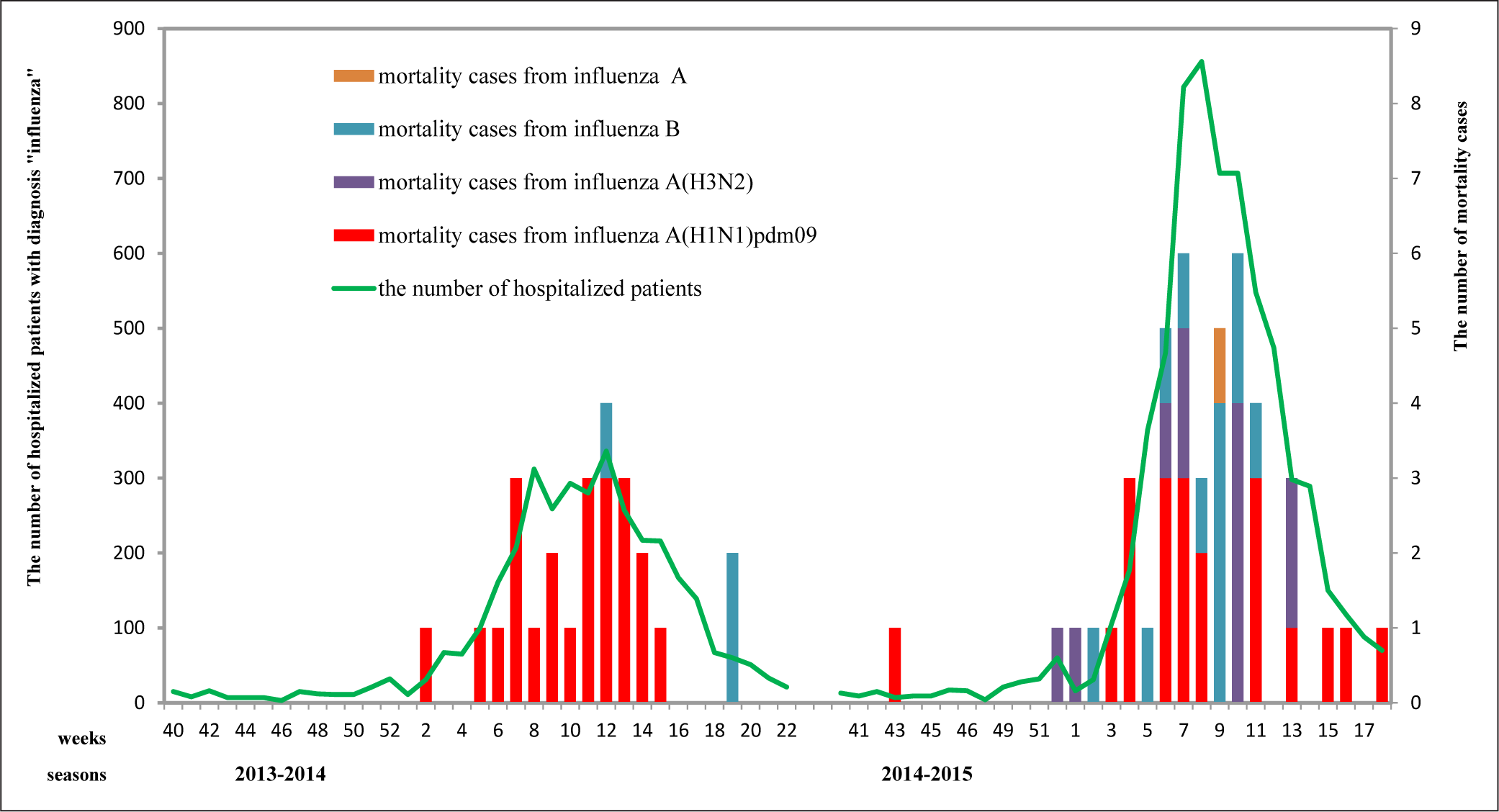
The majority - 52.3% - of fatality cases from the influenza virus were recorded for patients from 32 to 53 years old, 15.9% - for patients older than 65 years, and 11.4% - for children younger than 6 years (Fig. 5).
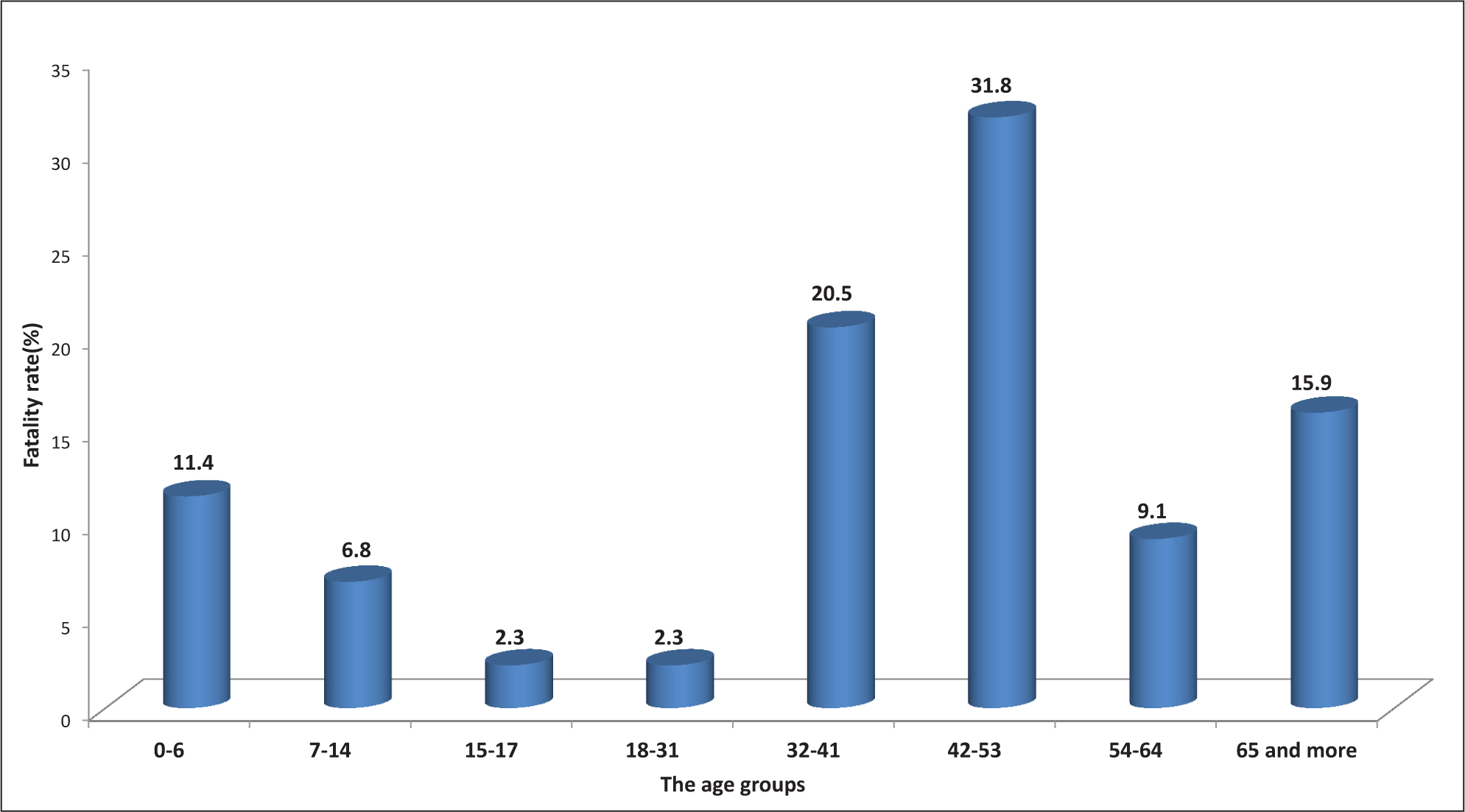
The majority of the fatality cases recorded for children under 14 years were caused by the influenza virus A(H3N2) - 11.4%, compared to the number of fatality cases caused by influenza viruses B - 4.5%, and A(H1N1)pdm09 -2.3% (Table 2, Fig. 6). The number of mortality cases for patients 15 to 64 years old from influenza virus A(H1N1)pdm09 - 38.6% - was much higher than the corresponding numbers for influenza viruses B - 15.9% - and A(H3N2) - 11.4%. The major causative agent for the fatality cases among the patients older than 65 years was the influenza virus B (6.8%), followed by the virus A(H1N1)pdm09 - 4.5%, virus A(H3N2) - 2.3% and virus A which subtype was not determined - 2.3%. Thus, during the last epidemic, the influenza virus A(H3N2) turned out to be the most dangerous for children, while for the elderly (older than 65 years) it was influenza virus B, and for the adult population younger than 64 years the major causative agent for mortality cases was the influenza virus A(H1N1)pdm09.
| Age of passed away patients | Identified influenza viruses | |||||||
|---|---|---|---|---|---|---|---|---|
| A(H1N1)pdm09 | B | A(H3N2) | A (type not identified) | |||||
| N | % | N | % | N | % | N | % | |
| All mortality cases* | 20 | 45.4 | 12 | 27.3 | 11 | 25.0 | 1 | 2.3 |
| 0 to 14 years old | 1 | 2.3 | 2 | 4.5 | 5 | 11.4 | - | - |
| 15 to 64 years old | 17 | 38.6 | 7 | 15.9 | 5 | 11.4 | - | - |
| Older than 65 years | 2 | 4.5 | 3 | 6.8 | 1 | 2.3 | 1 | 2.3 |
Total number of passed away patients – 44.
N - Number of passed away patients
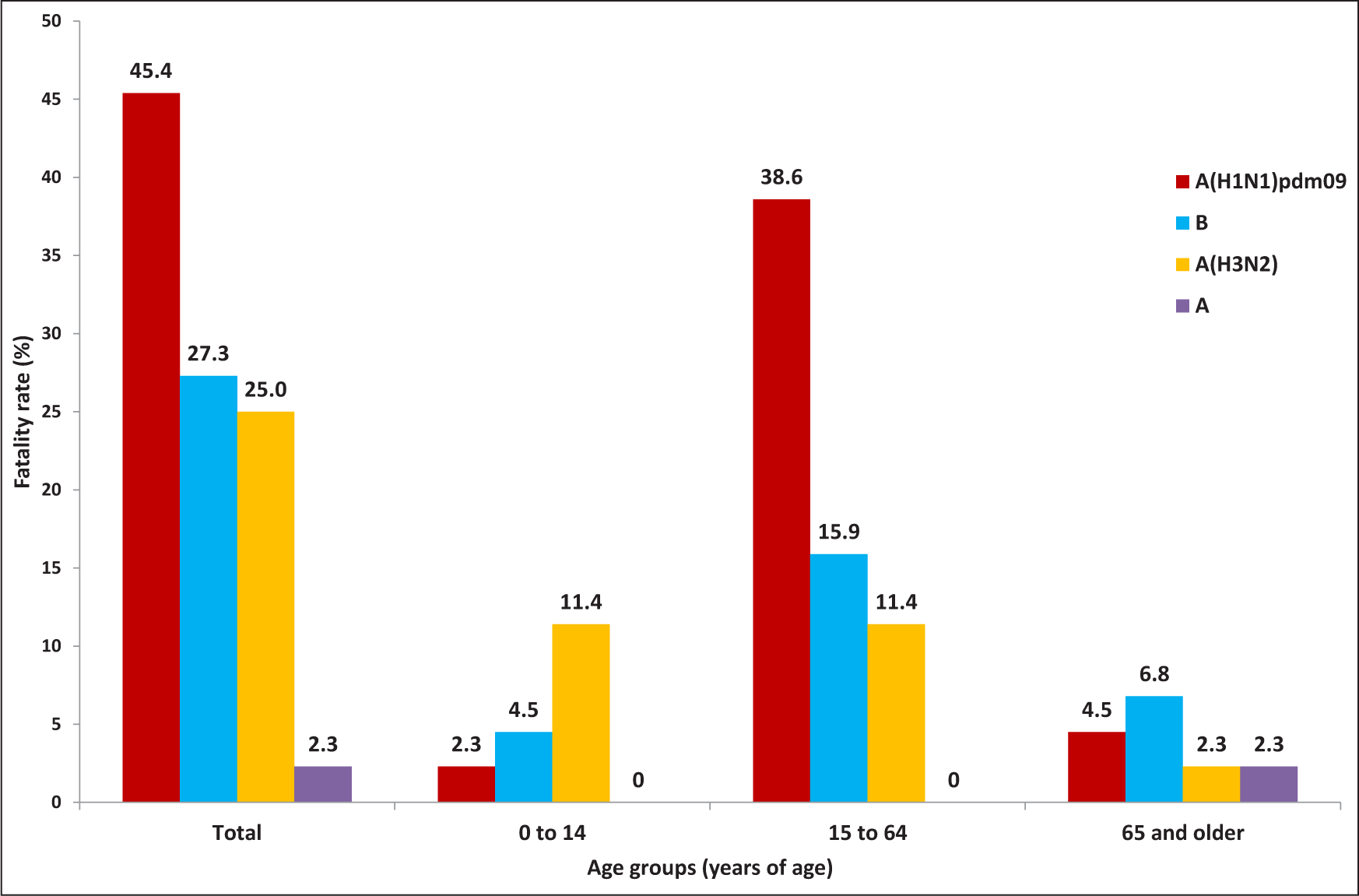
There were no recorded mortality cases from the influenza virus proved by the laboratory analysis in the Far East and Ural FDs during the 2014-2015 epidemic season. All the mortality cases from the influenza virus A(H1N1)pdm09 were recorded in the cities of the European part of Russia, where this virus had spread significantly: from 2.6% of all isolated from the patients viruses in the South FD, to 11.7% in the Central FD compared to 2.0% in the Far East FD, and not isolated at all in the Ural and Siberia FDs.
The presence of the chronic pathology serves as a risk factor for the mortality cases from the influenza (Fig. 7). After the analysis of the hierarchy of the pathology typical for fatal cases, it was found that the cardiovascular pathology (38.6%) together with the hepatitis, pancreatitis, and kidneys pathology (38.6%) plays a main role.
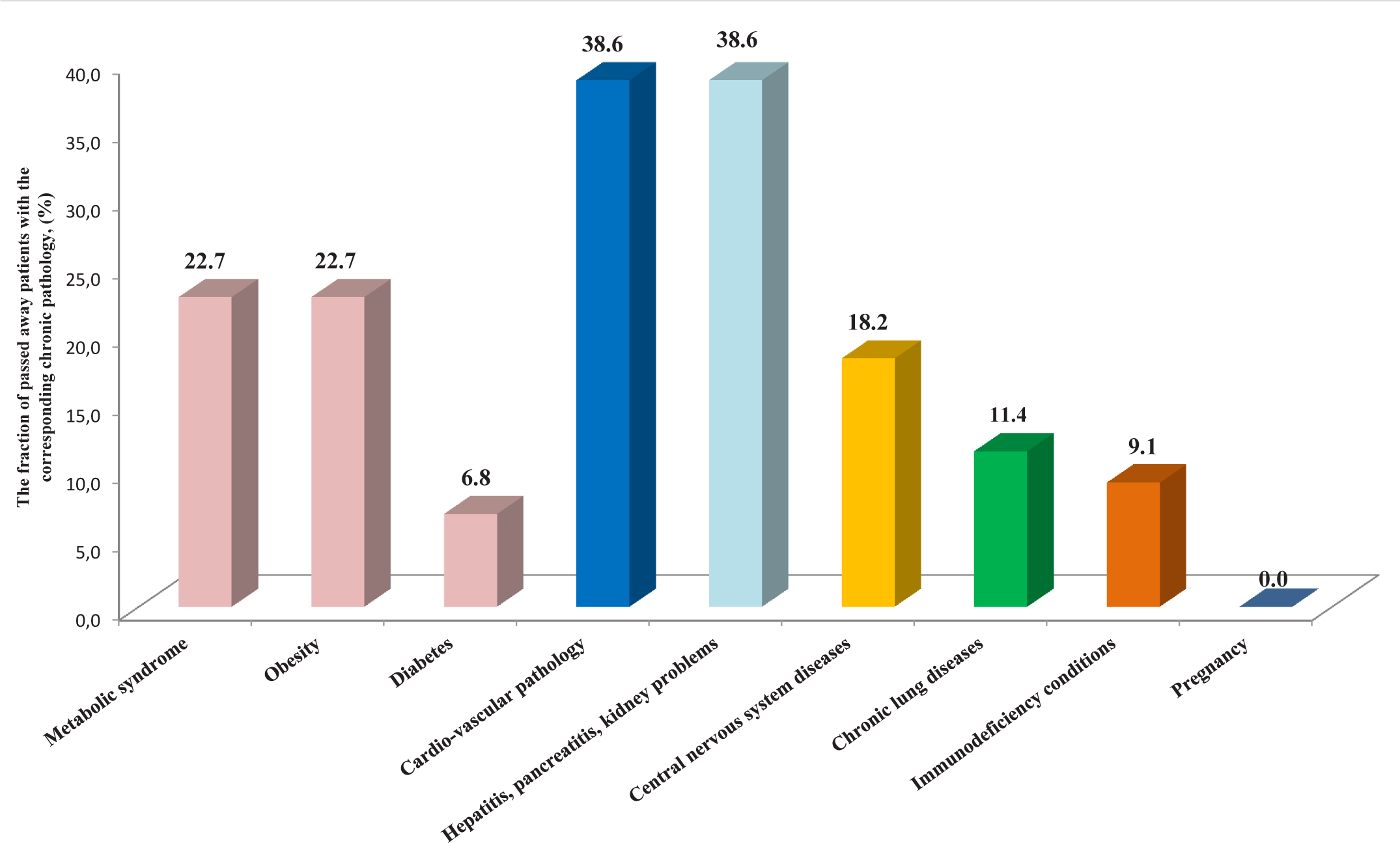
The metabolic syndrome (22.7%) including obesity (22.7%) and diabetes (6.8%) ranked second. The disorders of the central nervous system (18.2%), chronic lung diseases (11.4%), and immunodeficient conditions (9.1%) were also recorded as the pathological conditions in the patients who died from influenza. There were no pregnant women among the patients who passed away from the influenza in the last epidemic season in contrast to the pandemic 2009-2010 [14-16]. Apparently this was due to the sporadic spreading of the A(H1N1)pdm09 virus, as well as the package of measures for the pregnant women implemented by the Ministry of Health before the start of the epidemic.
Thus, the concurrent illnesses, particularly cardiovascular pathology, hepatitis and kidneys disorders, are the main risk factors leading to the mortality from the influenza viruses. The metabolic syndrome (diabetes, obesity) and lung disorders should be also considered as risk factors. On the other hand, the disorders of the central nervous system and immune system are the main factors leading to mortality from influenza among the children. It is important to mention that among those who passed away from the influenza virus, there were no vaccinated patients.
CONCLUSIONS
The influenza epidemic of the 2014-2015 season started earlier than the epidemic 2013-2014 and spread from Europe across Russia mainly in the direction to the East.
The 2014-2015 epidemic was more intense than the 2013-2014 epidemic due to the larger number of territories it spread to and the increased number of population age groups that were affected by the epidemic.
The morbidity rate at the peak of the 2014-2015 epidemic as well as the average length of the epidemic and the morbidity rate in the cities, especially among children 7 to 14 years old and adults, were higher than the corresponding numbers for the previous epidemic.
The influenza and ARVI patients’ hospitalization rate among the people older than 65 years in 2014-2015 was 1.4 times higher than in 2013-2014; the rate of the patients with the “influenza” diagnosis hospitalization was 2.7 times higher, and the number of the mortality cases from the influenza viruses proved by the laboratory analysis was 1.8 times higher.
It should be mentioned that while the spreading of the A(H1N1)pdm09 virus was sporadic and it was not the main etiological factor of the epidemic, this virus strain still remained the main causative agent for mortality cases (45.4% of the total number of mortality cases), especially among the adult population younger than 64 years old (38.6%). The lethal clinical outcomes from this virus were recorded only in the European part of Russian Federation.

